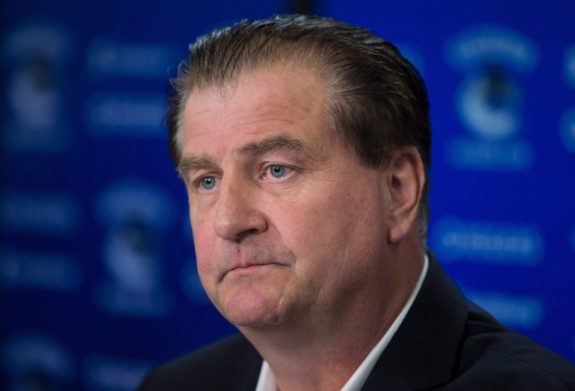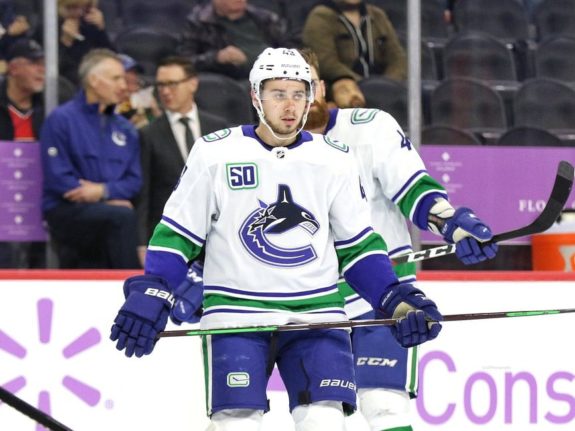The Vancouver Canucks have made a lot of changes this offseason. From blockbuster trades to saying goodbye to longtime players to bringing in a plethora of new faces, nearly two-thirds of the roster has turned over. Despite all of that, and just a few short weeks until the puck drops for the 2021-22 season, the Canucks still have two more boxes to check off in the restricted free agent (RFA) department.
While the Canucks have roughly $13.7 million in cap space, both Quinn Hughes and Elias Pettersson remain unsigned. While the rest of the team is preparing for the season at training camp, Hughes and Pettersson are on the sidelines. General manager Jim Benning addressed the situation on Wednesday, saying, “I’m going to continue to talk to Pat Brisson [who represents both players] and try to get something figured out here as soon as we can. I don’t think we’re that far apart, but these are complex and unique deals. These are two good young players and an important part of our group, so like I said, we’re going to continue to work with Pat until we get something figured out.”
Benning was able to get rid of some contracts to create cap space, but he also signed players that put the team in a tricky spot. While it would be great to get everybody locked up long-term, the Canucks will be forced to sign Hughes and Pettersson to bridge deals.
Canucks’ Lack Of Cap Space
Now, Benning made a conscious effort to alleviate cap space for the immediate future. He started by buying out goaltender Brayden Holtby, who had an average annual value (AAV) of $4.3 million. Then came the trades, moving players like Nate Schmidt to the Winnipeg Jets, and of course, the blockbuster deal with the Arizona Coyotes that shed three big contracts in Loui Eriksson ($6 million AAV), Antoine Roussel ($3 million AAV) and Jay Beagle ($3 million). On top of that, some veteran players walked now that their deals have expired, most notably Alexander Edler and his AAV of $6 million.

The counter to clearing said cap space, was what Vancouver took on in return. Starting with the Coyotes trade and the contract in defenseman Oliver Ekman-Larsson to the tune of $7.26 million AAV and in the acquisition of forward Conor Garland, who was extended to a five-year deal at $4.95 million AAV. Then there was the free agency period when Benning signed several free agents, and while they weren’t expensive, every bit adds up. Between Tucker Poolman ($2.5 million AAV), Jaroslav Halak ($1.5 million AAV), Luke Schenn ($850k AAV), and re-signing Travis Hamonic to a two-year deal at $3 million AAV, that’s $7.85 million against the cap before Hughes and Pettersson are signed. Throw in the extension of recently acquired Jason Dickinson from the Dallas Stars ($2.65 million AAV), and we’ve accounted for nearly $10 million in cap space. These aren’t necessarily bad moves, they just counteract what the original plan was going into the offseason.
Cost Of Vancouver’s Long-Term Deals Today
If the Canucks had any chance of locking up their two cornerstone players to long-term contracts, that time passed once Benning started spending in free agency. There was that period where a few notable young defensemen were extended. Cale Makar, Miro Heiskanen, and even Dougie Hamilton, all earned between $8.45-$9 million AAV. Regardless of the term, the blueprint to sign Hughes was there, but the Canucks never used it.
There weren’t as many comparable contracts on the forward market for Pettersson, but there was enough to go on. Sebastian Aho, who makes $8.4 million per season and Mikko Rantanen at $9.25 million per year are just a couple of names. The issue here is that Aho’s deal stemmed from an offer sheet extended by the Montreal Canadiens, which had a set price tag. On the other hand, Rantanen is a right-winger, which makes him a tough comparison to Pettersson, who is a natural center. There is a much broader range of players, from Auston Matthews at $11.64 million AAV to Leon Draisaitl at $8.5 million AAV, or Brayden Point, who was just extended with an AAV of $9.5 million, and most recently Kiril Kaprizov, who was signed to a five-year extension worth $9 million per season. The metrics are there, but it’s been a lengthier process than expected.
The Positives of Bridge Deals
Despite the scenario the Canucks are in right now, there are definitely positives to signing young stars to short-term bridge deals. The best example is Point of the Tampa Bay Lightning, who before being extended long-term at $9.5 million AAV, was on a three-year bridge deal worth $6.75 million a season, which the Lightning didn’t complain about.
Second, the cap usually goes up. Because of the COVID-19 pandemic, that didn’t happen, putting a plethora of teams in a difficult predicament. But as arenas open up to full capacity crowds, the league will generate revenue again and the cap ceiling will slowly rise.

Now that Rasmus Dahlin has signed a three-year bridge deal with an AAV of $6 million per year, we know the starting point for the Hughes camp. With Pettersson, Point or even Matthew Barzel, who was locked up to a three-year, $21 million contract last season, might be the best players for comparison. Whatever the outcome is, it doesn’t seem to be any animosity between the players and management, so expect them both to be signed within the coming weeks.
While the bridge deal option might be the only one for Vancouver and their two young stars, it might not be the worst thing either. All that matters is getting them signed before puck drop on opening night.